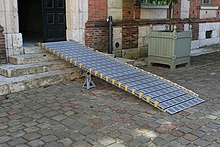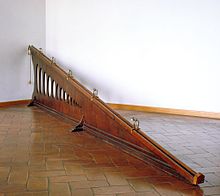
Back ተዳፋት AM Plan inclinau AN Òkwọọk ANN आनत तल ANP سطح منحدر Arabic Planu inclináu AST Наклонена равнина Bulgarian আনত তল Bengali/Bangla Kosa ravan BS Pla inclinat Catalan


An inclined plane, also known as a ramp, is a flat supporting surface tilted at an angle from the vertical direction, with one end higher than the other, used as an aid for raising or lowering a load.[1][2][3] The inclined plane is one of the six classical simple machines defined by Renaissance scientists. Inclined planes are used to move heavy loads over vertical obstacles. Examples vary from a ramp used to load goods into a truck, to a person walking up a pedestrian ramp, to an automobile or railroad train climbing a grade.[3]
Moving an object up an inclined plane requires less force than lifting it straight up, at a cost of an increase in the distance moved.[4] The mechanical advantage of an inclined plane, the factor by which the force is reduced, is equal to the ratio of the length of the sloped surface to the height it spans. Owing to conservation of energy, the same amount of mechanical energy (work) is required to lift a given object by a given vertical distance, disregarding losses from friction, but the inclined plane allows the same work to be done with a smaller force exerted over a greater distance.[5][6]
The angle of friction,[7] also sometimes called the angle of repose,[8] is the maximum angle at which a load can rest motionless on an inclined plane due to friction without sliding down. This angle is equal to the arctangent of the coefficient of static friction μs between the surfaces.[8]
Two other simple machines are often considered to be derived from the inclined plane.[9] The wedge can be considered a moving inclined plane or two inclined planes connected at the base.[5] The screw consists of a narrow inclined plane wrapped around a cylinder.[5]
The term may also refer to a specific implementation; a straight ramp cut into a steep hillside for transporting goods up and down the hill. This may include cars on rails or pulled up by a cable system; a funicular or cable railway, such as the Johnstown Inclined Plane.
- ^ Cole, Matthew (2005). Explore science, 2nd Ed. Pearson Education. p. 178. ISBN 978-981-06-2002-8.
- ^ Merriam-Webster's collegiate dictionary, 11th Ed. Merriam-Webster. 2003. pp. 629. ISBN 978-0-87779-809-5.
inclined plane definition dictionary.
- ^ a b "The Inclined Plane". Math and science activity center. Edinformatics. 1999. Retrieved March 11, 2012.
- ^ Silverman, Buffy (2009). Simple Machines: Forces in Action, 4th Ed. Canada: Heinemann-Raintree Classroom. p. 7. ISBN 978-1-4329-2317-4.
- ^ a b c Ortleb, Edward P.; Richard Cadice (1993). Machines and Work. Lorenz Educational Press. pp. iv. ISBN 978-1-55863-060-4.
- ^ Reilly, Travis (November 24, 2011). "Lesson 04:Slide Right on By Using an Inclined Plane". Teach Engineering. College of Engineering, Univ. of Colorado at Boulder. Archived from the original on May 8, 2012. Retrieved September 8, 2012.
- ^ Scott, John S. (1993). Dictionary of Civil Engineering. Chapman & Hill. p. 14. ISBN 978-0-412-98421-1.
angle of friction [mech.] in the study of bodies sliding on plane surfaces, the angle between the perpendicular to the surface and the resultant force (between the body and the surface) when the body begins to slide. angle of repose [s.m.] for any given granular material the steepest angle to the horizontal at which a heaped surface will stand in stated conditions.
- ^ a b Ambekar, A. G. (2007). Mechanism and Machine Theory. PHI Learning. p. 446. ISBN 978-81-203-3134-1.
Angle of repose is the limiting angle of inclination of a plane when a body, placed on the inclined plane, just starts sliding down the plane.
- ^ Rosen, Joe; Lisa Quinn Gothard (2009). Encyclopedia of Physical Science, Volume 1. Infobase Publishing. p. 375. ISBN 978-0-8160-7011-4.